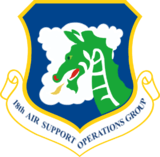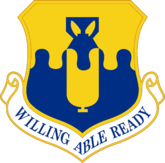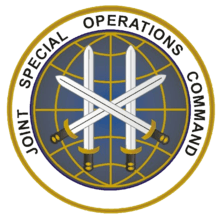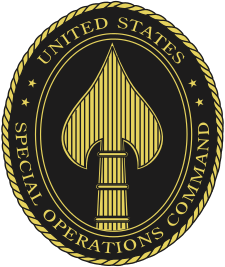Fort Bragg
| Fort Bragg | |
|---|---|
|
Cumberland / Hoke / Moore / Harnett counties, near Fayetteville, North Carolina | |
|
Insignia of units assigned to Fort Bragg | |
| Type | Military Base |
| Site information | |
| Controlled by | United States |
| Site history | |
| Built | 1918 |
| In use | 1918 – present |
| Garrison information | |
| Garrison |
For tenant units, See below |
Fort Bragg is an installation of the United States Army and is the largest military base in the world (by population) with more than 50,000 active duty personnel.[1] The base is located within Cumberland, Hoke, Harnett and Moore counties, North Carolina. Fort Bragg borders the towns of Fayetteville, Spring Lake and Southern Pines. It was also a census-designated place in the 2010 Census, during which a population of 39,457 was identified. The fort is named for Confederate general Braxton Bragg. It covers over 251 square miles (650 km2). It is the home of the Army's XVIII Airborne Corps and is the headquarters of the United States Army Special Operations Command, which oversees the Special Forces and Army Rangers. It is also home to the U.S. Army Forces Command, U.S. Army Reserve Command, and Womack Army Medical Center. Fort Bragg maintains two airfields: Pope Field, where the United States Air Force stations global airlift and special operations assets as well as the Air Force Combat Control School, and Simmons Army Airfield, where Army aviation units support the needs of airborne and special operations forces on the base.
History

| Fort Bragg, North Carolina | |
|---|---|
| CDP | |
 Fort Bragg, North Carolina Location within the state of North Carolina | |
| Coordinates: 35°8′21″N 78°59′57″W / 35.13917°N 78.99917°WCoordinates: 35°8′21″N 78°59′57″W / 35.13917°N 78.99917°W | |
| Country | United States |
| State | North Carolina |
| County | Cumberland |
| Area | |
| • Total | 251.0 sq mi (650.2 km2) |
| • Land | 249.7 sq mi (646.8 km2) |
| • Water | 1.3 sq mi (3.4 km2) |
| Population (2010) | |
| • Total | 39,457 |
| • Density | 1,540.0/sq mi (594.6/km2) |
| Time zone | Eastern (EST) (UTC-5) |
| • Summer (DST) | EDT (UTC-4) |
| ZIP codes | 28307, 28310 |
| Area code(s) | 910 |
| FIPS code | 37-24260[2] |
World War I
Camp Bragg was established in 1918 as an artillery training ground. The Chief of Field Artillery, General William J. Snow, was seeking an area having suitable terrain, adequate water, rail facilities and a climate for year-round training, and he decided that the area now known as Fort Bragg met all of the desired criteria.[3] Camp Bragg was named to honor a native North Carolinian, Braxton Bragg, who commanded Confederate States Army forces in the Civil War.
The aim was for six artillery brigades to be stationed there and $6,000,000 was spent on the land and cantonments.[4] There was an airfield on the camp used by aircraft and balloons for artillery spotters. The airfield was named Pope Field on April 1, 1919, in honor of First Lieutenant Harley H. Pope,[4] an airman who was killed while flying nearby. The work on the camp was finished on November 1, 1919.[4]
The original plan for six brigades was abandoned after World War I ended[4] and once demobilization had started. The artillery men, their equipment and material from Camp McClellan, Alabama, were moved over to Fort Bragg and testing began on long-range weapons that were a product of the war.[4] The six artillery brigades were reduced to two cantonments and a garrison was to be built for Army troops as well as a National Guard training center.[4] In early 1921 two field artillery units, the 13th and 17th Field Artillery Brigades, began training at Camp Bragg. The same year, the Long Street Church and six acres of property were acquired for the reservation.[5] The church was listed on the National Register of Historic Places in 1974.[6]
Due to the post-war cutbacks, the camp was nearly closed for good when the War department issued orders to close the camp on August 7, 1921. General Albert J. Bowley was commander at the camp and after much campaigning, and getting the Secretary of War to visit the camp, the closing order was cancelled on September 16, 1921. The Field Artillery Board was transferred to Fort Bragg on February 1, 1922.
Camp Bragg was renamed Fort Bragg, to signify becoming a permanent Army post, on September 30, 1922. From 1923 to 1924 permanent structures were constructed on Fort Bragg, including four barracks.[4]
World War II
By 1940, during World War II, the population of Fort Bragg had reached 5,400; however, in the following year, that number ballooned to 67,000. Various units trained at Fort Bragg during World War II, including the 9th Infantry Division, 2nd Armored Division, 82nd Airborne Division, 100th Infantry Division, and various field artillery groups. The population reached a peak of 159,000 during the war years.[7]
Cold War
Following World War II, the 82nd Airborne Division was permanently stationed at Fort Bragg, the only large unit there for some time. In July 1951, the XVIII Airborne Corps was reactivated at Fort Bragg. Fort Bragg became a center for unconventional warfare, with the creation of the Psychological Warfare Center in April 1952, followed by the 10th Special Forces Group.[8]
In 1961, the 5th Special Forces Group (Airborne) was activated at Fort Bragg, with the mission of training counter-insurgency forces in Southeast Asia. Also in 1961, the "Iron Mike" statue, a tribute to all Airborne soldiers, past, present and future, was dedicated.[9] More than 200,000 young men underwent basic combat training here during the period 1966–70. At the peak of the Vietnam War in 1968, Fort Bragg's military population rose to 57,840. In June 1972, the 1st Corps Support Command arrived at Fort Bragg.[10]
In the 1980s, there was a series of deployments of tenant units to the Caribbean, first to Grenada in 1983, Honduras in 1988, and to Panama in 1989. The 5th Special Forces Group departed Fort Bragg in the late 1980s.[11]
Middle East wars

In 1990, the XVIII Airborne Corps and the 82nd Airborne Division deployed to Saudi Arabia in support of Operation Desert Shield and Operation Desert Storm. In the mid- and late 1990s, there was increased modernization of the facilities in Fort Bragg. The World War II wooden barracks were largely removed, a new main post exchange was built, and Devers Elementary School was opened, along with several other projects.[12]
As a result of campaigns in Afghanistan and Iraq, the units on Fort Bragg have seen a sizeable increase to their operations tempo (OPTEMPO), with units conducting two, three, or even four or more deployments to combat zones. As directed by law, and in accordance with the recommendations of the 2005 Base Realignment and Closure Commission, Fort McPherson, Georgia, closed and U.S. Army Forces Command and U.S. Army Reserve Command relocated to Fort Bragg, North Carolina. A new FORSCOM/U.S. Army Reserve Command Headquarters facility completed construction at Fort Bragg in June 2011. Forces Command hosted June 24, 2011 an Army "casing of colors ceremony" on Fort McPherson and an "uncasing of colors ceremony" on August 1, 2011, at Fort Bragg. On March 1, 2011, Pope Field, the former Pope Air Force Base, was absorbed into Fort Bragg.
Tenant units
- Hover the cursor over the top right infobox insignias to see the selected unit name. Or navigate using the Fort Bragg template at the foot of this page — use the 'show' link to display it.
The major commands at the installation are the United States Army Forces Command, the United States Army Reserve Command, and the United States Army Special Operations Command. Several airborne and special operations units of the United States Army are stationed at Fort Bragg, notably the 82nd Airborne Division, the 3rd Special Forces Group (Airborne), and the Delta Force. The latter is controlled by the Joint Special Operations Command, based at Pope Field within Fort Bragg.
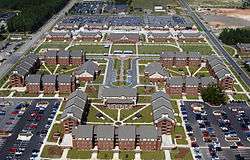

- XVIII Airborne Corps:
- Headquarters, XVIII Airborne Corps
- 82nd Airborne Division
- DIvision Headquarters and Headquarters Battalion, 82nd Airborne Division
- 1st Infantry Brigade Combat Team
- 2nd Infantry Brigade Combat Team
- 3rd Infantry Brigade Combat Team
- 82nd Airborne Division Artillery
- 82nd Airborne Division Sustainment Brigade
- 18th Field Artillery Brigade
- 20th Engineer Brigade
- United States Army Special Operations Command:
- United States Army Special Forces Command (Special Forces)
- Headquarters and Headquarters Company
- 3rd Special Forces Group (Airborne)
- Special Forces Operational Detachment-Delta (SFOD-D) (a.k.a. "Delta Force")
- United States Army Special Operations Aviation Command
- 4th Military Information Support Group (Airborne)
- 95th Civil Affairs Brigade (Airborne)
- 528th Sustainment Brigade (Airborne)
- John F. Kennedy Special Warfare Center and School
- United States Army Special Forces Command (Special Forces)
- Other Army units on base:
- 1st Theater Sustainment Command
- 525th Military Intelligence Brigade
- 16th Military Police Brigade
- 44th Medical Brigade
- 108th Air Defense Artillery Brigade
- 1st Battalion, 313th Regiment (Logistics Support Battalion)
- 407th Brigade Support Battalion
- 127th Brigade Engineer Battalion
- B Company, 249th Engineer Battalion (Prime Power)
- 50th Expeditionary Signal Battalion
- Army units at Simmons Army Airfield:
- Army units at Pope Field:
- Air Force units at Pope Field:
- Other units at Pope Field:
- Joint Special Operations Command
- Special Forces Operational Detachment-Delta
- Joint Special Operations Command
Geography and ecology
Fort Bragg is at 35°8'21" North, 78°59'57" West (35.139064, −78.999143).[13]
According to the United States Census Bureau, the post has a total area of 19.0 square miles (49.2 km²), of which, 19.0 square miles (49.1 km²) of it is land and 0.1 square miles (0.2 km²) of it is water. The total area is 0.32% water.
International security website Globalsecurity.org reports that Fort Bragg occupies approximately 160,700 acres (650 km2)
Ft. Bragg is the only locality where the endangered Saint Francis' Satyr butterfly (Neonympha mitchellii francisci) is known to occur. St. Francis’ satyr is found in wetland habitat dominated by graminoids and sedges such as abandoned beaver dams or along streams with active beaver complexes.
Fort Bragg fever, a bacterial zoonotic disease, has been named after it.
In 1990, the endangered, red-cockaded woodpecker came under the protection of the U.S. Fish and Wildlife Service. This caused a tremendous problem for Fort Bragg, where many of these birds lived. Training stopped, ranges were closed, and troops were temporarily moved to other installations for training.
The Army and the conservationists eventually came to an agreement, which put in place training restrictions around the woodpeckers' habitat. White stripes were painted on trees to indicate the location of the habitats, and restrictions limited the scope and duration of training that could take place within 200 feet of these locations.
Today, the clusters of woodpeckers has more than doubled in size (200 to 493), and many of the training restrictions have been lifted.[14]
Demographics
| Historical population | |||
|---|---|---|---|
| Census | Pop. | %± | |
| 1970 | 46,995 | — | |
| 1980 | 37,834 | −19.5% | |
| 1990 | 34,744 | −8.2% | |
| 2000 | 29,183 | −16.0% | |
| 2010 | 39,457 | 35.2% | |
| source:[15] | |||
As of the census[2] of 2000, there are 29,183 people, 4,315 households, and 4,215 families residing on the base. The population density is 1,540.0 people per square mile (594.6/km²). There are 4,420 housing units at an average density of 233.3/sq mi (90.1/km²).
Racial makeup
The racial makeup of the base is 58.1% Caucasian, 25.3% African-American, 1.2% Native American, 1.8% Asian, 0.9% Pacific Islander, 8.3% from other races, and 4.6% from two or more races. 15.8% of the population are Hispanic or Latino of any race.
Households
There are 4,315 households out of which 85.3% have children under the age of 18 living with them, 88.9% are married couples living together, 7.2% have a female householder with no husband present, and 2.3% are non-families. 2.1% of all households are made up of individuals and 0.0% have someone living alone who is 65 years of age or older. The average household size is 3.72 and the average family size is 3.74.
Ages
The age distribution is 25.8% under the age of 18, 40.9% from 18 to 24, 32.3% from 25 to 44, 1.1% from 45 to 64, and 0.1% who are 65 years of age or older. The median age is 22 years. For every 100 females there are 217.1 males. For every 100 females age 18 and over, there are 293.5 males. All of these statistics are typical for military bases.
Income
The median income for a household on the base is $30,106, and the median income for a family is $29,836. 10.0% of the population and 9.6% of families are below the poverty line. Out of the total population, 11.4% of those under the age of 18 and 0.0% of those 65 and older are living below the poverty line.
Notable events
- In January 1942, Mickey Rooney visited Fort Bragg to entertain the soldiers.[16] Two years later, he was drafted and served in the Army until the end of World War II.
- On October 12, 1961, President John F. Kennedy visits Ft. Bragg and the US Army Special Warfare Center and officializes the wear of the Green Beret.[17]
- In 1967, Manuel Noriega, who would later go on to become the dictator of Panama, received Psyop training at this location.
- On February 17, 1970, the pregnant wife and two daughters of Jeffrey R. MacDonald were murdered. The events surrounding the murders were retold in the book Fatal Vision, itself made into a television miniseries of the same name.
- On May 10, 1987, President Ronald Reagan visits during a USO show with Bob Hope and other celebrities.[18]
- On July 1, 1987, a C-130 crashes during a public demonstration at the Sicily Drop Zone. Four airmen and one soldier die.[19]
- On October 27, 1995, William Kreutzer, Jr. opened fire at Fort Bragg, killing an officer and wounding 18 other soldiers.
- On June 28, 2005, President George W. Bush gave a nationally televised speech at Fort Bragg to reaffirm the United States' mission in Iraq.
- On December 13, 2011, WWE hosted its annual Tribute to the Troops for Fort Bragg at the Fayetteville Crown Coliseum with special guest stars Robin Williams, Nickelback, and Mary J. Blige.
- On December 14, 2011, President Barack Obama gave a nationally televised speech thanking soldiers for their service in Operation Iraqi Freedom.[20]
- In 2012, Ashley Broadway, the wife of Lt. Col. Heather Mack, was denied full membership to the Association of Bragg Officers' Spouses.[21]
- On June 28, 2012, Specialist Ricky G. Elder shot and killed Lieutenant Colonel Roy L. Tisdale of the 525th Battlefield Surveillance Brigade during a safety brief. The soldier also shot himself and injured two other fellow soldiers.[22] He later died of his injuries.[23]
- On January 20, 2013, Army Times highlights the experience of a married same-sex couple at Fort Bragg, both servicemembers, who are denied the housing allowance and other benefits that are available to different-sex married servicemembers.[24]
- On March 8, 2016, Major League Baseball announced that the Atlanta Braves and Miami Marlins would play a special neutral-site game at Fort Bragg Stadium, a newly constructed ballpark at Fort Bragg, on July 3, 2016. It will be the first time that an active military installation has hosted a regular-season game of a professional sports league. The game will be attended primarily by military members.[25] In addition, the game was the first Major League Baseball regular season game ever held in the state of North Carolina.[26] The ballpark was built on a disused golf course and sat 12,500 fans for the game, a 5–2 Marlins win televised live on ESPN. Following the conclusion of the game, the grandstands and other facilities are to be removed, and the field will become a multi-use sporting ground.[27]
Notable people
- Michael Blake, author and screenwriter
- Jason Miller (born 1980), retired mixed martial arts fighter, grew up on Fort Bragg
- Ernie Logan, Former NFL football player
- Joe Morris, Super Bowl champion and two-time Pro Bowl running back
- Julianne Moore, actress (born 1960)
Burials
Actress Martha Raye is buried on Fort Bragg in commemoration of her work with the USO during World War II and Vietnam.[28]
See also
| Wikimedia Commons has media related to Fort Bragg. |
- The Special Warfare Memorial Statue (Bronze Bruce)
- Pathfinder
- Pope Field
- Simmons Army Airfield
- 82nd Airborne Division War Memorial Museum
- Camp Mackall
- United Service Organization of North Carolina
- Exercise Swarmer
- United States Army Forces Command
- William Kreutzer, Jr. (Fort Bragg sniper)
Notes
- ↑ http://www.army-technology.com/features/feature-largest-military-bases-world-united-states/[]
- 1 2 "American FactFinder". United States Census Bureau. Retrieved 2008-01-31.
- ↑ "Fort Bragg History". Fort Bragg. U.S. Army Fort Bragg. Retrieved 16 July 2013.
- 1 2 3 4 5 6 7 "1919–1939". XVIII Airborne. Retrieved July 13, 2010.
- ↑ Survey and Planning Unit Staff (October 1973). "Long Street Church" (pdf). National Register of Historic Places - Nomination and Inventory. North Carolina State Historic Preservation Office. Retrieved 2015-01-01.
- ↑ National Park Service (2010-07-09). "National Register Information System". National Register of Historic Places. National Park Service.
- ↑ "History of Fort Bragg, 1940s". http://www.bragg.army.mil/ Fort Bragg’s online website. Retrieved January 25, 2007. External link in
|work=(help) - ↑ "History of Fort Bragg, 1950s". http://www.bragg.army.mil/ Fort Bragg’s online website. Retrieved January 25, 2007. External link in
|work=(help) - ↑ "History of Fort Bragg, 1960s". http://www.bragg.army.mil/ Fort Bragg’s online website. Retrieved January 25, 2007. External link in
|work=(help) - ↑ "History of Fort Bragg, 1970s". http://www.bragg.army.mil/ Fort Bragg’s online website. Retrieved January 25, 2007. External link in
|work=(help) - ↑ "History of Fort Bragg". http://www.bragg.army.mil/ Fort Bragg’s online website. Retrieved January 25, 2007. External link in
|work=(help) - ↑ "History of Fort Bragg, 1990s". http://www.bragg.army.mil/ Fort Bragg’s online website. Retrieved January 25, 2007. External link in
|work=(help) - ↑ "US Gazetteer files: 2010, 2000, and 1990". United States Census Bureau. 2011-02-12. Retrieved 2011-04-23.
- ↑ Brooks, Drew. "Fort Bragg and Red-cockaded Woodpecker Co-exist". Military.com. Fayetteville Observer. Retrieved 21 August 2014.
- ↑ "CENSUS OF POPULATION AND HOUSING (1790–2000)". U.S. Census Bureau. Retrieved July 25, 2010.
- ↑ Associated Press. "WWII Entertainment Rooney 1942". Richmond.com. Richmond Times-Dispatch. Retrieved 7 July 2016.
- ↑ http://www.jfklibrary.org/JFK/JFK-in-History/Green-Berets.aspx
- ↑ http://www.reagan.utexas.edu/archives/photographs/celebrities.html
- ↑ United Press International (1 July 1987). "4 Killed in Air Show Plane Crash". L.A. Times. Retrieved 2 March 2016.
- ↑ Nicholas, Peter (December 14, 2011). "At Ft. Bragg, Obama welcomes troops home from Iraq". Los Angeles Times. Retrieved January 26, 2013.
- ↑ Brooks, Drew (26 January 2013). "Lesbian Wife Named Fort Bragg's Spouse of the Year". Military.com. Fayetteville Observer.
- ↑ "Official: Battalion commander dead in Fort Bragg shooting". MSNBC. Archived from the original on October 22, 2013. Retrieved 22 October 2013.
- ↑ Santora, Marc (July 1, 2012). "Gunman in Fort Bragg Shooting Dies". The New York Times.
- ↑ Crary, David; Miesecker, Michael (January 20, 2013). "DOMA a roadblock for same-sex military couples". Army Times. Retrieved January 22, 2013.
- ↑ Brooks, Drew (March 8, 2016). "Braves, Marlins to play at Fort Bragg this summer in new ballpark". The Fayetteville Observer. Fayetteville Publishing Co. Retrieved March 8, 2016.
- ↑ Carter, Andrew (July 3, 2016). "Fort Bragg celebrates history in first Major League Baseball game in North Carolina". The News & Observer. Fort Bragg: The McClatchy Company. Retrieved July 3, 2016.
- ↑ Mock, Joe (July 4, 2016). "Marlins top Braves in unique Fort Bragg Game". USA Today. Fort Bragg: Gannett Company. Retrieved July 4, 2016.
- ↑ "Martha Raye Buried at Fort Bragg". Gadsden Times. Associated Press. October 23, 1994. Retrieved October 6, 2012.
External links
- Fort Bragg Homepage
- Military and Democracy – Segment from C-SPAN's Alexis de Tocqueville Tour, featuring interview with Lt. Gen. John M. Keane filmed at Fort Bragg.
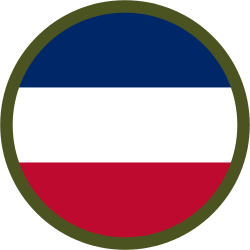



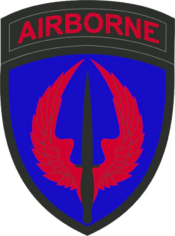

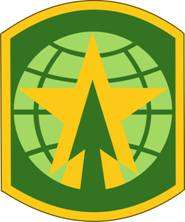




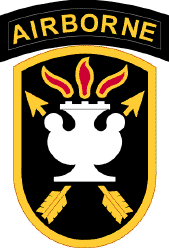




_small.jpg)

